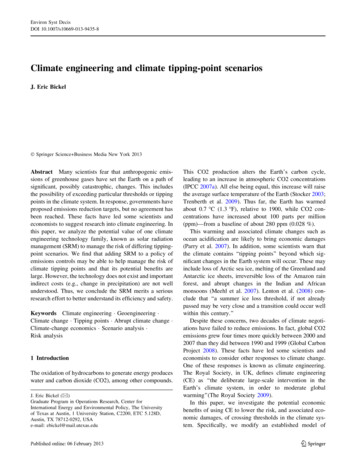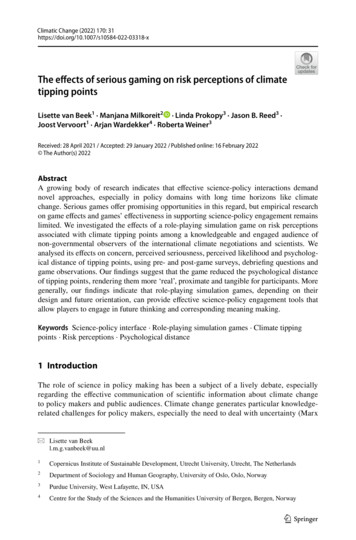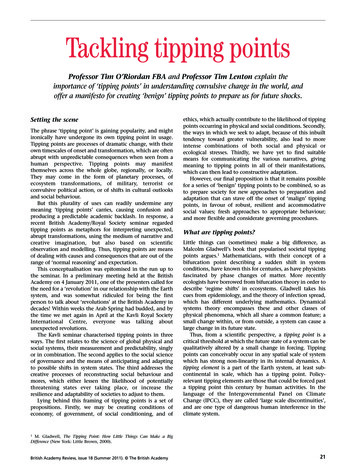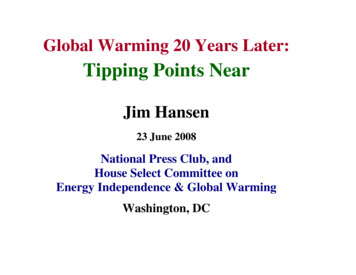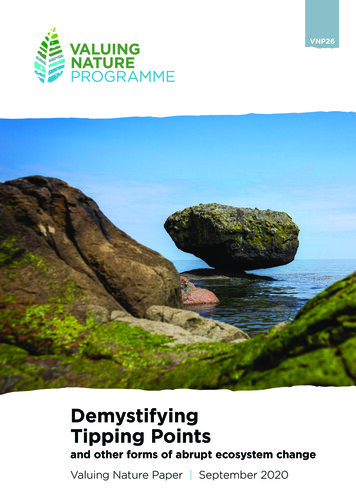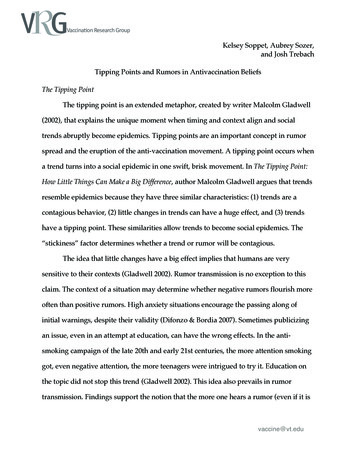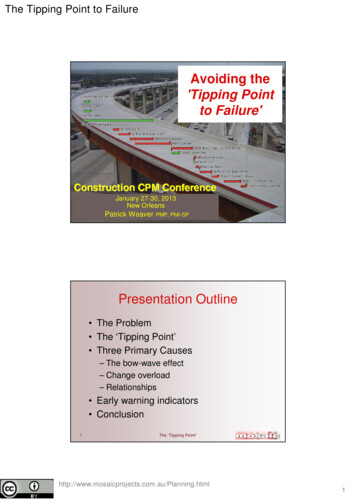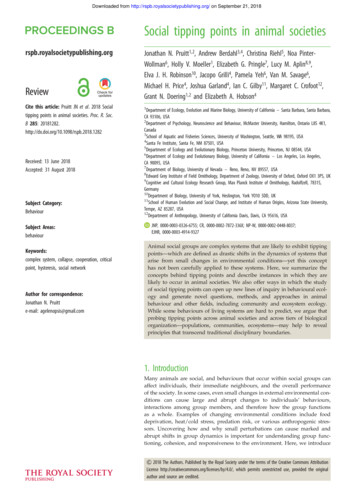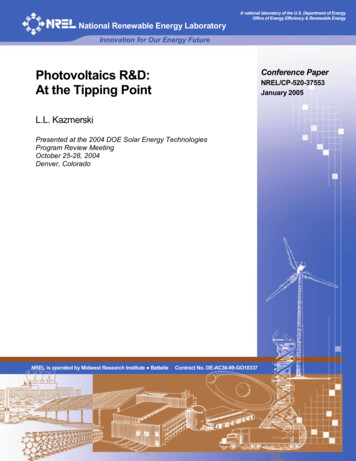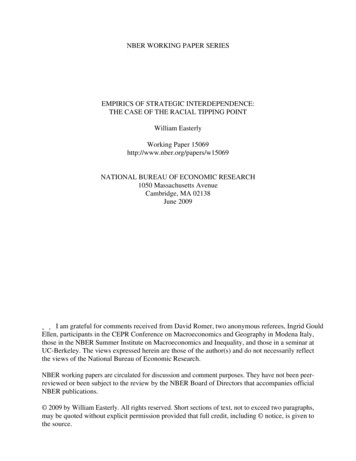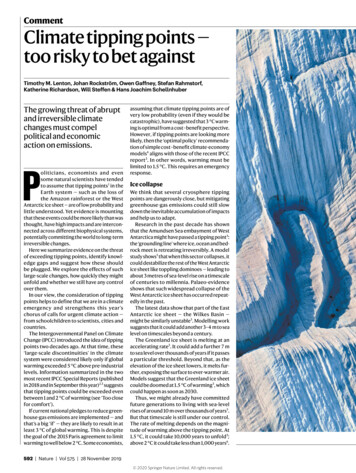
Transcription
CommentClimate tipping points —too risky to bet againstTimothy M. Lenton, Johan Rockström, Owen Gaffney, Stefan Rahmstorf,Katherine Richardson, Will Steffen & Hans Joachim SchellnhuberThe growing threat of abruptand irreversible climatechanges must compelpolitical and economicaction on emissions.Politicians, economists and evensome natural scientists have tendedto assume that tipping points1 in theEarth system — such as the loss ofthe Amazon rainforest or the WestAntarctic ice sheet — are of low probability andlittle understood. Yet evidence is mountingthat these events could be more likely than wasthought, have high impacts and are interconnected across different biophysical systems,potentially committing the world to long-termirreversible changes.Here we summarize evidence on the threatof exceeding tipping points, identify knowledge gaps and suggest how these shouldbe plugged. We explore the effects of suchlarge-scale changes, how quickly they mightunfold and whether we still have any controlover them.In our view, the consideration of tippingpoints helps to define that we are in a climateemergency and strengthens this year’schorus of calls for urgent climate action —from schoolchildren to scientists, cities andcountries.The Intergovernmental Panel on ClimateChange (IPCC) introduced the idea of tippingpoints two decades ago. At that time, these‘large-scale discontinuities’ in the climatesystem were considered likely only if globalwarming exceeded 5 C above pre-industriallevels. Information summarized in the twomost recent IPCC Special Reports (publishedin 2018 and in September this year)2,3 suggeststhat tipping points could be exceeded evenbetween 1 and 2 C of warming (see ‘Too closefor comfort’).If current national pledges to reduce greenhouse-gas emissions are implemented — andthat’s a big ‘if’ — they are likely to result in atleast 3 C of global warming. This is despitethe goal of the 2015 Paris agreement to limitwarming to well below 2 C. Some economists,Ice collapseWe think that several cryosphere tippingpoints are dangerously close, but mitigatinggreenhouse-gas emissions could still slowdown the inevitable accumulation of impactsand help us to adapt.Research in the past decade has shownthat the Amundsen Sea embayment of WestAntarctica might have passed a tipping point3:the ‘grounding line’ where ice, ocean and bedrock meet is retreating irreversibly. A modelstudy shows5 that when this sector collapses, itcould destabilize the rest of the West Antarcticice sheet like toppling dominoes — leading toabout 3 metres of sea-level rise on a timescaleof centuries to millennia. Palaeo-evidenceshows that such widespread collapse of theWest Antarctic ice sheet has occurred repeatedly in the past.The latest data show that part of the EastAntarctic ice sheet — the Wilkes Basin —might be similarly unstable3. Modelling worksuggests that it could add another 3–4 m to sealevel on timescales beyond a century.The Greenland ice sheet is melting at anaccelerating rate3. It could add a further 7 mto sea level over thousands of years if it passesa particular threshold. Beyond that, as theelevation of the ice sheet lowers, it melts further, exposing the surface to ever-warmer air.Models suggest that the Greenland ice sheetcould be doomed at 1.5 C of warming3, whichcould happen as soon as 2030.Thus, we might already have committedfuture generations to living with sea-levelrises of around 10 m over thousands of years3.But that timescale is still under our control.The rate of melting depends on the magnitude of warming above the tipping point. At1.5 C, it could take 10,000 years to unfold3;above 2 C it could take less than 1,000 years6.devresersthgirllA.detimiLerutaNregnirpS0202 592 Nature Vol 575 28 November 2019assuming that climate tipping points are ofvery low probability (even if they would becatastrophic), have suggested that 3 C warming is optimal from a cost–benefit perspective.However, if tipping points are looking morelikely, then the ‘optimal policy’ recommendation of simple cost–benefit climate-economymodels4 aligns with those of the recent IPCCreport2. In other words, warming must belimited to 1.5 C. This requires an emergencyresponse.
Researchers need more observational datato establish whether ice sheets are reaching atipping point, and require better models constrained by past and present data to resolvehow soon and how fast the ice sheets couldcollapse.Whatever those data show, action must betaken to slow sea-level rise. This will aid adaptation, including the eventual resettling of large,low-lying population centres.A further key impetus to limit warming to1.5 C is that other tipping points could betriggered at low levels of global warming. The“The clearest emergencywould be if we wereapproaching a globalcascade of tipping points.”latest IPCC models projected a cluster of abruptshifts7 between 1.5 C and 2 C, several of whichinvolve sea ice. This ice is already shrinkingrapidly in the Arctic, indicating that, at 2 C ofwarming, the region has a 10–35% chance3 ofbecoming largely ice-free in summer.An aeroplane flies over a glacier in the Wrangell St Elias National Park in Alaska.Climate change and other human activitiesrisk triggering biosphere tipping points acrossa range of ecosystems and scales (see ‘Raisingthe alarm’).Ocean heatwaves have led to mass coralbleaching and to the loss of half of theshallow-water corals on Australia’s GreatBarrier Reef. A staggering 99% of tropical coralsare projected2 to be lost if global average temperature rises by 2 C, owing to interactionsbetween warming, ocean acidification and pollution. This would represent a profound loss ofmarine biodiversity and human livelihoods.As well as undermining our life-supportsystem, biosphere tipping points can triggerabrupt carbon release back to the atmosphere.This can amplify climate change and reduceremaining emission budgets.Deforestation and climate change aredestabilizing the Amazon — the world’s largestrainforest, which is home to one in ten knownspecies. Estimates of where an Amazon tippingpoint could lie range from 40% deforestationto just 20% forest-cover loss8. About 17% hasbeen lost since 1970. The rate of deforestation varies with changes in policy. Finding the tipping point requires models thatinclude deforestation and climate change asinteracting drivers, and that incorporate fireand climate feedbacks as interacting tippingmechanisms across scales.With the Arctic warming at least twiceas quickly as the global average, the borealforest in the subarctic is increasingly vulnerable. Already, warming has triggered largescale insect disturbances and an 02 Nature Vol 575 28 November 2019 593FRANS LANTING/NAT. GEO. IMAGE COLLECTIONBiosphere boundaries
ALEXIS ROSENFELD/GETTYCommentcould happen through ocean and atmosphericcirculation or through feedbacks that increasegreenhouse-gas levels and global temperature. Alternatively, strong cloud feedbackscould cause a global tipping point12,13.TOO CLOSE FOR COMFORTAbrupt and irreversible changes in the climate systemhave become a higher risk at lower global averagetemperature rise. This has been suggested for largeevents such as the partial disintegration of theAntarctic ice sheet.Level of riskHighModerateUndetectable6Rise in global mean surface temperaturerelative to pre-industrial levels (ºC)in fires that have led to dieback of NorthAmerican boreal forests, potentially turningsome regions from a carbon sink to a carbonsource9. Permafrost across the Arctic is beginning to irreversibly thaw and release carbondioxide and methane — a greenhouse gas thatis around 30 times more potent than CO2 overa 100-year period.Researchers need to improve their understanding of these observed changes in majorecosystems, as well as where future tippingpoints might lie. Existing carbon stores andpotential releases of CO2 and methane needbetter quantification.The world’s remaining emissions budgetfor a 50:50 chance of staying within 1.5 C ofwarming is only about 500 gigatonnes (Gt) ofCO2. Permafrost emissions could take an estimated 20% (100 Gt CO2) off this budget10, andthat’s without including methane from deeppermafrost or undersea hydrates. If forestsare close to tipping points, Amazon diebackcould release another 90 Gt CO2 and borealforests a further 110 Gt CO2 (ref. 11). Withglobal total CO2 emissions still at more than40 Gt per year, the remaining budget couldbe all but erased already.543Global averagetemperature: 1 ºC abovepre-industriallevels21Global cascadeIn our view, the clearest emergency wouldbe if we were approaching a global cascadeof tipping points that led to a new, less habitable, ‘hothouse’ climate state11. Interactions02001 2009 2014 2018*Year*The 2018 IPCC Special Report: Global Warming of 1.5 ºCfocuses on the temperature range up to 2.5 ºC.devresersthgirllA.detimiLerutaNregnirpS0202 594 Nature Vol 575 28 November 2019 Corrected 7 April 2020We argue that cascading effects mightbe common. Research last year14 analysed30 types of regime shift spanning physicalclimate and ecological systems, from collapseof the West Antarctic ice sheet to a switchfrom rainforest to savanna. This indicatedthat exceeding tipping points in one systemcan increase the risk of crossing them in others. Such links were found for 45% of possibleinteractions14.In our view, examples are starting to beobserved. For example, Arctic sea-ice lossis amplifying regional warming, and Arcticwarming and Greenland melting are driving an influx of fresh water into the NorthAtlantic. This could have contributed to a 15%slowdown15 since the mid-twentieth centuryof the Atlantic Meridional Overturning Circulation (AMOC) , a key part of global heat andsalt transport by the ocean3. Rapid meltingof the Greenland ice sheet and further slowdown of the AMOC could destabilize theWest African monsoon, triggering droughtin Africa’s Sahel region. A slowdown in theAMOC could also dry the Amazon, disrupt theEast Asian monsoon and cause heat to buildup in the Southern Ocean, which could accelerate Antarctic ice loss.The palaeo-record shows global tipping,such as the entry into ice-age cycles 2.6 million years ago and their switch in amplitudeand frequency around one million yearsago, which models are only just capable ofSOURCE: IPCC AND J. B. SMITH ET AL. PROC. NATL ACAD. SCI. USA 106, 4133–4137 (2009)Bleached corals on a reef near the island of Moorea in French Polynesia in the South Pacific.
EMERGENCY:DO THE MATHSWe define emergency (E) as the productof risk and urgency. Risk (R) is definedby insurers as probability (p) multipliedby damage (D). Urgency (U) is defined inemergency situations as reaction time toan alert (τ) divided by the intervention timeleft to avoid a bad outcome (T). Thus:E R U p D τ/TThe situation is an emergency if both riskand urgency are high. If reaction timeis longer than the intervention time left(τ / T 1), we have lost control.Greenland ice sheetIce loss acceleratingBoreal forestFires and pestschangingArctic sea iceReduction in areaPermafrostThawingAtlantic circulationIn slowdown since 1950sAmazon rainforestFrequent droughtsCoral reefsLarge-scale die-offsTipping pointsConnectivityRAISING THE ALARMEvidence that tipping pointsare under way has mountedin the past decade. Dominoeffects have also beenproposed.Wilkes Basin,East AntarcticaIce loss acceleratingWest Antarctic ice sheetIce loss acceleratingconfidence in their ability to forecast these.Some scientists counter that the possibilityof global tipping remains highly speculative.It is our position that, given its huge impactand irreversible nature, any serious riskassessment must consider the evidence,however limited our understanding mightstill be. To err on the side of danger is not aresponsible option.If damaging tipping cascades can occur anda global tipping point cannot be ruled out,then this is an existential threat to civilization.No amount of economic cost–benefit analysisis going to help us. We need to change ourapproach to the climate problem.Act nowIn our view, the evidence from tippingpoints alone suggests that we are in a stateof planetary emergency: both the risk andurgency of the situation are acute (see‘Emergency: do the maths’).We argue that the intervention time left toprevent tipping could already have shrunktowards zero, whereas the reaction time toachieve net zero emissions is 30 years at best.Hence we might already have lost control ofwhether tipping happens. A saving grace isthat the rate at which damage accumulatesfrom tipping — and hence the risk posed —could still be under our control to some extent.The stability and resilience of our planet isin peril. International action — not just words— must reflect this.Research, Germany. Owen Gaffney is aglobal sustainability analyst at the PotsdamInstitute for Climate Impact Research,Germany; and at the Stockholm ResilienceCentre, Stockholm University, Sweden.Stefan Rahmstorf is professor of physicsof the oceans at the University of Potsdam;and head of Earth system analysis at thePotsdam Institute for Climate ImpactResearch, Germany. Katherine Richardson isprofessor of biological oceanography at theGlobe Institute, University of Copenhagen,Denmark. Will Steffen is emeritus professorof climate and Earth System science at theAustralian National University, Canberra,Australia. Hans Joachim Schellnhuber isfounding director of the Potsdam Institutefor Climate Impact Research, Germany; anddistinguished visiting professor, TsinghuaUniversity, Beijing, China.e-mail: t.m.lenton@exeter.ac.uk1.2.3.4.5.6.7.8.9.10.11.The authorsTimothy M. Lenton is director of theGlobal Systems Institute, University ofExeter, UK. Johan Rockström is director ofthe Potsdam Institute for Climate Impact12.13.14.15.Lenton, T. M. et al. Proc. Natl Acad. Sci. USA 105,1786–1793 (2008).IPCC. Global Warming of 1.5 C (IPCC, 2018).IPCC. IPCC Special Report on the Ocean and Cryospherein a Changing Climate (IPCC, 2019).Cai, Y., Lenton, T. M., & Lontzek, T. S. Nature Clim. Change6, 520–525 (2016).Feldmann, J. & Levermann, A. Proc. Natl Acad. Sci. USA112, 14191–14196 (2015).Aschwanden, A. et al. Sci. Adv. 5, eaav9396 (2019).Drijfhout, S. et al. Proc. Natl Acad. Sci. USA 112,E5777–E5786 (2015).Lovejoy, T. E. & Nobre, C. Sci. Adv. 4, eaat2340 (2018).Walker, X. J. et al. Nature 572, 520–523 (2019).Rogelj, J., Forster, P. M., Kriegler, E., Smith, C. J. &Séférian, R. Nature 571, 335–342 (2019).Steffen, W. et al. Proc. Natl Acad. Sci. USA 115, 8252–8259(2018).Schneider, T., Kaul, C. M. & Pressel, K. G. Nature Geosci.12, 163–167 (2019).Tan, I., Storelvmo, T. & Zelinka, M. D. Science 352, 224–227(2016).Rocha, J. C., Peterson, G., Bodin, Ö. & Levin, S. Science362, 1379–1383 (2018).Caesar, L., Rahmstorf, S., Robinson, A., Feulner, G. &Saba, V. Nature 556, 191–196 (2018).devresersthgirllA.detimiLerutaNregnirpS0202 Nature Vol 575 28 November 2019 595SOURCE: T. M. LENTON ET AL.simulating. Regional tipping occurred repeatedly within and at the end of the last ice age,between 80,000 and 10,000 years ago (theDansgaard–Oeschger and Heinrich events).Although this is not directly applicable to thepresent interglacial period, it highlights thatthe Earth system has been unstable acrossmultiple timescales before, under relativelyweak forcing caused by changes in Earth’sorbit. Now we are strongly forcing the system, with atmospheric CO2 concentrationand global temperature increasing at ratesthat are an order of magnitude higher thanthose during the most recent deglaciation.Atmospheric CO2 is already at levels last seenaround four million years ago, in the Plioceneepoch. It is rapidly heading towards levels lastseen some 50 million years ago — in the Eocene— when temperatures were up to 14 C higherthan they were in pre-industrial times. It ischallenging for climate models to simulatesuch past ‘hothouse’ Earth states. One possible explanation is that the models have beenmissing a key tipping point: a cloud-resolvingmodel published this year suggests that theabrupt break-up of stratocumulus cloud aboveabout 1,200 parts per million of CO2 could haveresulted in roughly 8 C of global warming12.Some early results from the latest climatemodels — run for the IPCC’s sixth assessmentreport, due in 2021 — indicate a much largerclimate sensitivity (defined as the temperature response to doubling of atmosphericCO2) than in previous models. Many moreresults are pending and further investigationis required, but to us, these preliminary resultshint that a global tipping point is possible.To address these issues, we need models thatcapture a richer suite of couplings and feedbacks in the Earth system, and we need moredata — present and past — and better ways touse them. Improving the ability of models tocapture known past abrupt climate changesand ‘hothouse’ climate states should increase
CorrectionThe figure ‘Too close for comfort’ in thisComment incorrectly synthesized andinterpreted information from the IPCC. Thegraph labelled the temperatures as absolute, rather than rises; misrepresented thelevels of risk; misinterpreted information ascoming from a 2007 IPCC report; extrapolated the focus of a 2018 report; and was notclear about the specific sources of the information. The graphic has been extensivelymodified online to correct these errors.devresersthgirllA.detimiLerutaNregnirpS0202
species. Estimates of where an Amazon tipping point could lie range from 40% deforestation to just 20% forest-cover loss8. About 17% has been lost since 1970. The rate of deforest-ation varies with changes in policy. Find-ing the tipping point requires models that include deforestation and climate change as
